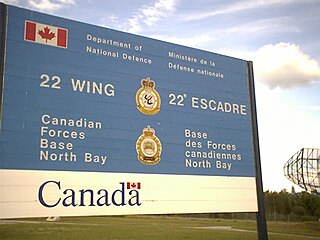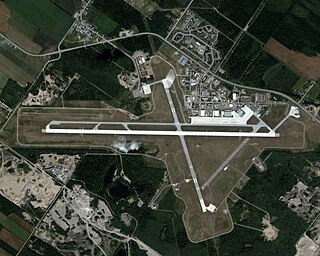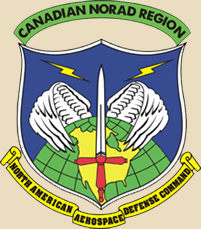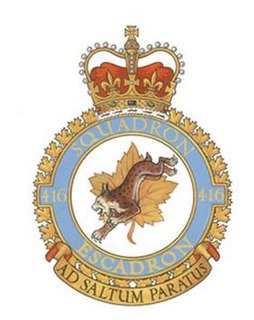The history of the Royal Canadian Air Force begins in 1920, when the air force was created as the Canadian Air Force (CAF). In 1924 the CAF was renamed the Royal Canadian Air Force (RCAF) when it was granted the royal title by King George V. The RCAF existed as an independent service until 1968. Prior attempts at forming an air force for Canada were the Canadian Aviation Corps that was attached to the Canadian Expeditionary Force, and a two-squadron Canadian Air Force that was attached to the Royal Air Force.

Canadian Forces Base North Bay, also CFB North Bay, is an air force base located at the City of North Bay, Ontario about 350 km (220 mi) north of Toronto. The base is subordinate to 1 Canadian Air Division, Winnipeg, Manitoba, and is the centre for North American Aerospace Defense Command (NORAD) operations in Canada, under the Canadian NORAD Region Headquarters, also in Winnipeg. It is also home to the 1 Air Force, Detachment 2 of the United States Air Force.

The Avro Canada CF-100 Canuck is a Canadian twinjet interceptor/fighter designed and produced by aircraft manufacturer Avro Canada. It has the distinction of being the only Canadian-designed fighter to enter mass production.

The Royal Canadian Air Force is the air and space force of Canada. Its role is to "provide the Canadian Forces with relevant, responsive and effective airpower". The RCAF is one of three environmental commands within the unified Canadian Armed Forces. As of 2020, the Royal Canadian Air Force consists of 12,074 Regular Force and 1,969 Primary Reserve personnel, supported by 1,518 civilians, and operates 258 manned aircraft and nine unmanned aerial vehicles. Lieutenant-General Eric Kenny is the current commander of the Royal Canadian Air Force and chief of the Air Force Staff.

The McDonnell CF-101 Voodoo was an all-weather interceptor aircraft operated by the Royal Canadian Air Force and the Canadian Forces between 1961 and 1984. They were manufactured by the McDonnell Aircraft Corporation of St. Louis, Missouri for the United States Air Force, and later sold to Canada. CF-101s replaced the obsolete Avro CF-100 Canuck in the RCAF's all-weather fighter squadrons. The Voodoo's primary armament was nuclear AIR-2A Genie unguided air-to-air rockets, and there was significant political controversy in Canada about their adoption. Although they never fired a weapon in wartime, the CF-101 served as Canada's primary means of air defence from Quick Reaction Alert facilities at Canadian airbases. The CF-101s were retired in the 1980s and replaced with McDonnell Douglas CF-18 Hornet fighters. Many examples are preserved in museums and parks in Canada and the United States.

Canadian Forces Base Bagotville, commonly referred to as CFB Bagotville, and also known as Bagotville Airport or Saguenay-Bagotville Airport, is a Canadian Forces base located 4.5 nautical miles west of Bagotville in the city of Saguenay. Located in the centre of Quebec, less than 200 km (120 mi) north of Quebec City, CFB Bagotville is operated as an air force base by the Royal Canadian Air Force (RCAF) and is one of two bases in the country using the CF-18 Hornet fighter/interceptor, the other being CFB Cold Lake. Its primary RCAF lodger unit is 3 Wing, commonly referred to as 3 Wing Bagotville.

Canadian Forces Base Gander, is a Canadian Forces base located in Gander, Newfoundland and Labrador. It is operated as an air force base by the Royal Canadian Air Force and is home to search and rescue operations that cover a vast swath of the western North Atlantic and southern Arctic and a Canadian Coastal Radar station amongst other things. It is home to 9 Wing Gander.

Canadian Forces Base St. Hubert was a Canadian Forces Base in the city of Saint-Hubert, Quebec. The base began as a civilian airfield in the 1920s and was later also used by RCAF auxiliary (reserve) squadrons, beginning in the mid-1930s. It became a fully-fledged RCAF station early in World War II, being extensively used for training as part of the British Commonwealth Air Training Plan. After the war, it grew into one of the most important air bases in Canada, and remained so for decades.

409 Tactical Fighter Squadron is a unit of the Royal Canadian Air Force. The squadron operates the CF-18 Hornet from CFB Cold Lake in Alberta, Canada.

1 Canadian Air Division is the operational-level command and control formation of the Royal Canadian Air Force (RCAF). Prior to 2006 the official abbreviation for the division was 1 CAD. It is commanded by an air force major-general.
Canadian Forces Station Lowther is a closed General Surveillance Radar station. It is located 12.7 miles (20.4 km) east-southeast of Mattice-Val Côté, Ontario. It was closed in 1987.

No. 414 Squadron RCAF is a Royal Canadian Air Force squadron. It is currently located in Ottawa and conducts electronic warfare support training for other units in the Canadian Armed Forces.

No. 428 Squadron RCAF, also known as 428 Bomber Squadron, and 428 Ghost Squadron, was first a night bomber squadron of the Royal Canadian Air Force engaged in strategic bombing during World War II, based in Yorkshire. At the end of the war the squadron moved to Nova Scotia before being disbanded in September 1945. In 1954 the squadron was reformed as 428 All-Weather (Fighter) Squadron, before being again disbanded in 1961.

416 "City of Oshawa" Tactical Fighter Squadron was a unit of the Canadian Forces and the Royal Canadian Air Force. The squadron operated the CF-18 Hornet fighter jet from CFB Cold Lake in Alberta, Canada. In 2006, 416 TFS stood down and was amalgamated with 441 Tactical Fighter Squadron to form 409 Tactical Fighter Squadron.

425 Tactical Fighter Squadron (French: 425e Escadron d'appui tactique, also "Alouette" Squadron, is a unit of the Royal Canadian Air Force. It operates CF-18 Hornet fighter jets from CFB Bagotville in Quebec, Canada. The squadron was originally formed during the Second World War.
RCAF Station St. Margarets is a former Royal Canadian Air Force station and later a Canadian Forces detachment located in the community of St. Margarets, New Brunswick.

Canadian Forces Station Sioux Lookout is a closed General Surveillance Radar station. It is located 3.7 miles (6.0 km) west of Sioux Lookout, Ontario. It was closed in 1987.

General Thomas James Lawson is a retired Royal Canadian Air Force general. Lawson was Chief of the Defence Staff of the Canadian Armed Forces from October 2012 to July 2015. He previously served as Deputy Commander of the North American Aerospace Defence Command.

Canada's Air Defence is a 33-minute 1957 Canadian documentary film produced by the National Film Board of Canada (NFB) for the Royal Canadian Air Force (RCAF). The film depicts the role of air defence over Canada and the United States by following the training and operational exercises of a RCAF squadron.
Royal Canadian Air Force Station St. Sylvestre was a Radar station of the Canadian Pinetree Line, located at Saint-Sylvestre, Quebec, in the Lotbinière Region, sixty-nine kilometres south Quebec City. Construction starting in 1952, the Station opened on 15 September 1953, first as RCAF Station Ste-Marie, being renamed RCAF Station St. Sylvestre, on 1 August 1955.